Air Purifier vs Air Conditioner: A Quick Comparison
When it comes to maintaining a comfortable and healthy indoor environment, both air purifiers and air conditioners (ACs) play essential roles. However, they serve different purposes and function in distinct ways. Let’s break down these two devices and highlight the key differences between them. In this article we try to know the facts about air purifier vs air conditioner.
Overview of Air Purifiers
An air purifier is a device designed to remove contaminants and pollutants from the air in your home or office. It works by circulating air through a filtration system that captures dust, allergens, pet dander, smoke, and other airborne particles. Air purifiers are particularly effective at improving indoor air quality, especially in areas with high pollution levels or for individuals suffering from respiratory issues such as asthma and allergies.
How Air Purifiers Work
Air purifiers typically use multiple stages of filtration to clean the air:
- Pre-filters – Capture large particles like dust and pet hair.
- HEPA Filters – Trap fine particles such as pollen, dust mites, and pet dander.
- Activated Carbon Filters – Absorb odors and gases such as VOCs and smoke.
- UV-C Lights (some models) – Destroy bacteria, viruses, and mold spores.
Air purifiers don’t cool or heat the air. Their primary function is to clean the air, which can lead to better overall air quality and a healthier living environment.
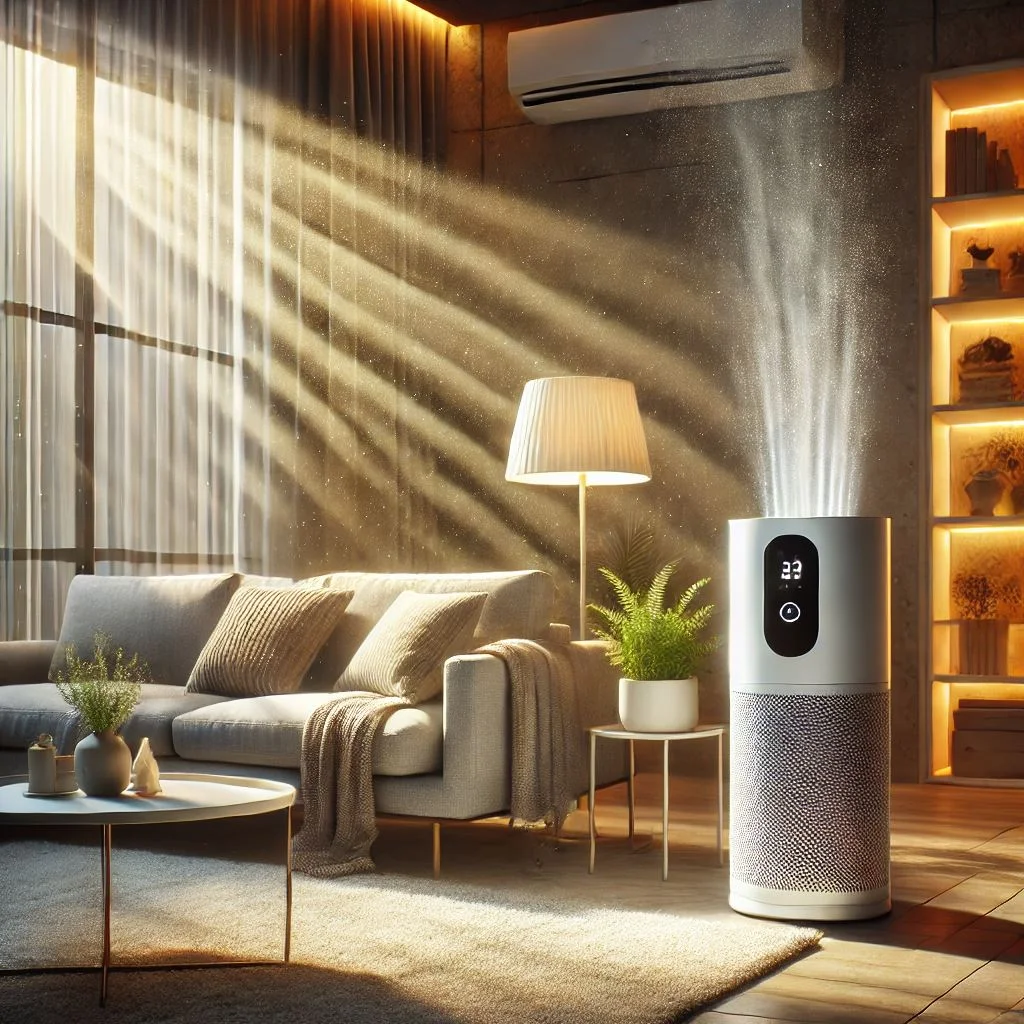
Overview of Air Conditioners
An air conditioner (AC) is primarily designed to cool indoor spaces by removing heat from the air. It works through a refrigeration cycle that transfers heat from inside your home to the outside, creating a more comfortable and cool indoor climate. ACs are not specifically designed to purify the air, although they can remove some particulate matter through basic filtration.
How Air Conditioners Work
AC units typically consist of:
- Compressor – Compresses refrigerant gas, increasing its temperature and pressure.
- Evaporator Coil – Absorbs heat from the indoor air.
- Condenser Coil – Releases the absorbed heat outside the building.
- Filters – Trap large particles like dust and debris, but not as effectively as air purifiers.
While air conditioners provide cooling and humidity control, they do not address indoor air quality in the same way air purifiers do. Some advanced air conditioners include air filters, but their main function remains temperature regulation.
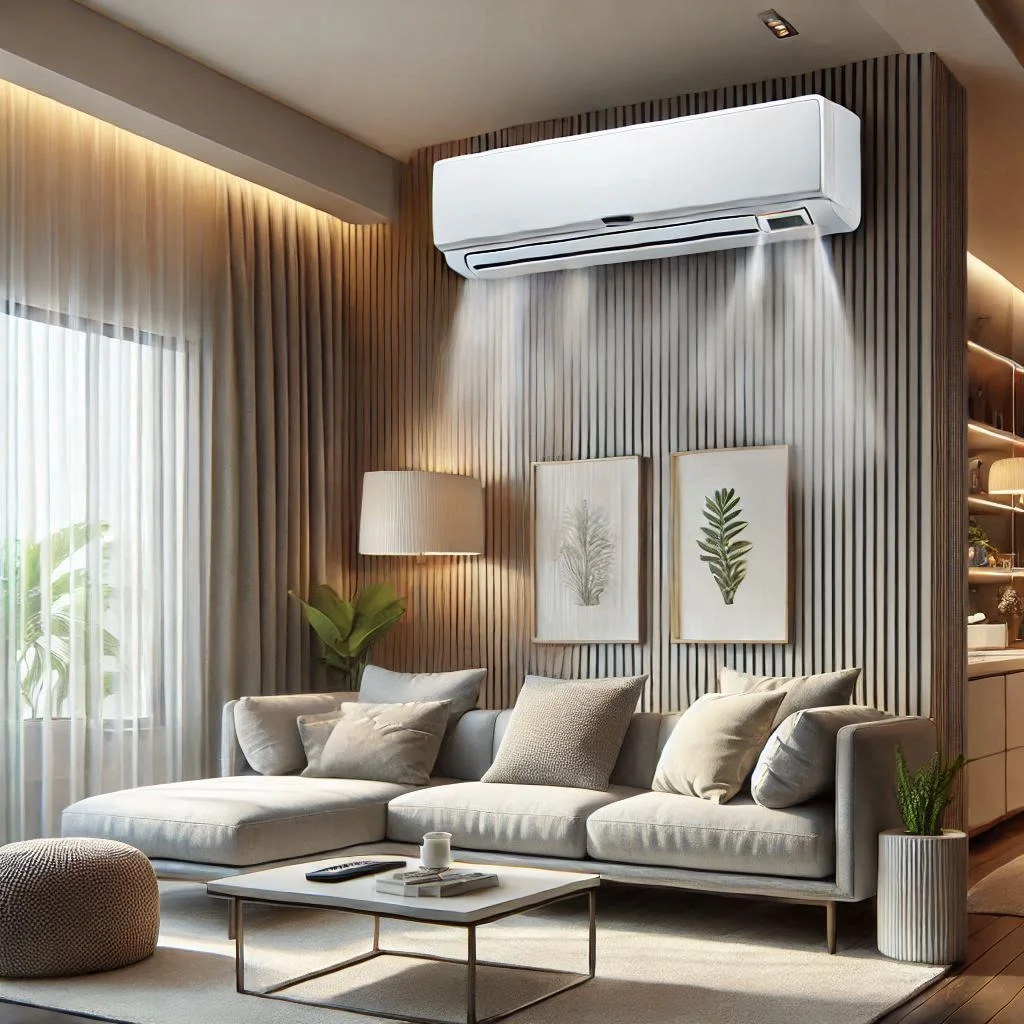
Key Differences in Functionality
While both devices improve comfort indoors, they serve very different functions:
- Purpose:
- Air Purifiers: Focus on cleaning and improving air quality by removing pollutants and allergens.
- Air Conditioners: Focus on cooling and regulating temperature within a room.
- Filtration:
- Air Purifiers: Equipped with advanced filters like HEPA and activated carbon, which target microscopic particles and gases.
- Air Conditioners: Have basic filters that remove larger particles like dust but are not designed to remove allergens or chemicals.
- Air Quality Impact:
- Air Purifiers: Dramatically improve indoor air quality, making them ideal for individuals with allergies, asthma, or other respiratory issues.
- Air Conditioners: Provide a comfortable environment by cooling the air but don’t significantly improve air quality beyond basic filtration.
- Energy Use:
- Air Purifiers: Typically consume less energy as they don’t involve cooling or heating mechanisms.
- Air Conditioners: Use more energy due to the cooling process and the associated machinery.
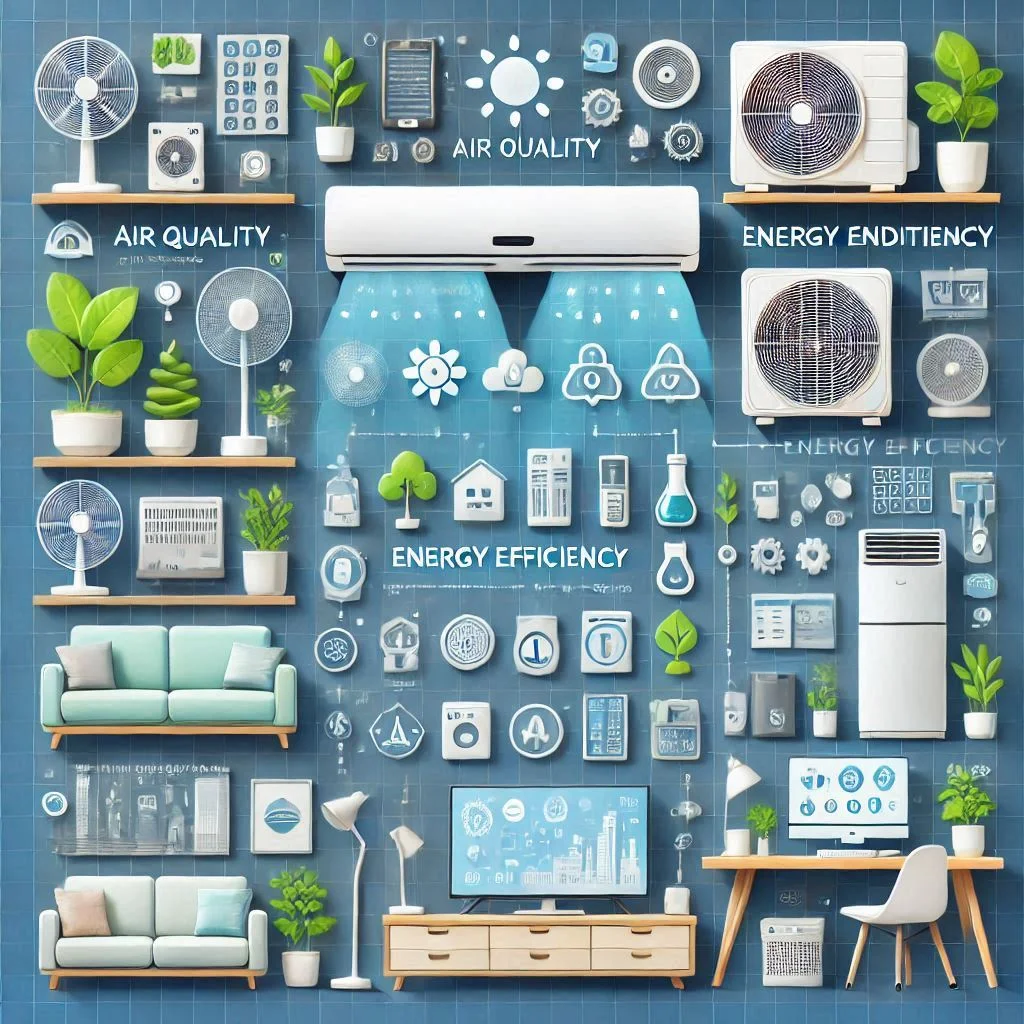
By understanding the distinct roles and features of air purifiers and air conditioners, you can make an informed decision based on your specific needs. Whether you prioritize cleaner air or cooler temperatures, choosing the right device will ensure a more comfortable and healthy living environment.
2. Air Purifiers and Air Conditioners: How They Work
Both air purifiers and air conditioners are essential home appliances that improve indoor comfort, but they operate in fundamentally different ways. Understanding how these devices work will help you make a more informed decision based on your needs.
How Air Purifiers Function
An air purifier works by drawing in air from the surrounding environment and passing it through a series of filters to capture airborne particles, such as dust, pollen, pet dander, and bacteria. The primary purpose of an air purifier is to clean the air, making it safer and healthier to breathe.
Stages of Air Purification
- Air Intake: The air purifier pulls in air from the room through vents or a fan.
- Filtration Process: The air passes through several filtration stages:
- Pre-filters: These capture larger particles like dust, hair, and lint.
- HEPA Filters: High-Efficiency Particulate Air (HEPA) filters are highly effective at trapping small particles, such as pollen, dust mites, and pet dander, making them ideal for allergy sufferers.
- Activated Carbon Filters: These absorb gases and odors, such as cigarette smoke, VOCs (volatile organic compounds), and cooking odors.
- UV-C Light (optional in some models): Ultraviolet-C light is used to destroy harmful bacteria, viruses, and mold spores, ensuring cleaner air.
- Clean Air Output: The purified air is then released back into the room, ensuring that the indoor air is fresh and free from contaminants.
Air purifiers are especially effective in areas where air quality is a concern. They do not alter the temperature or humidity of the air but focus entirely on air filtration and purification.
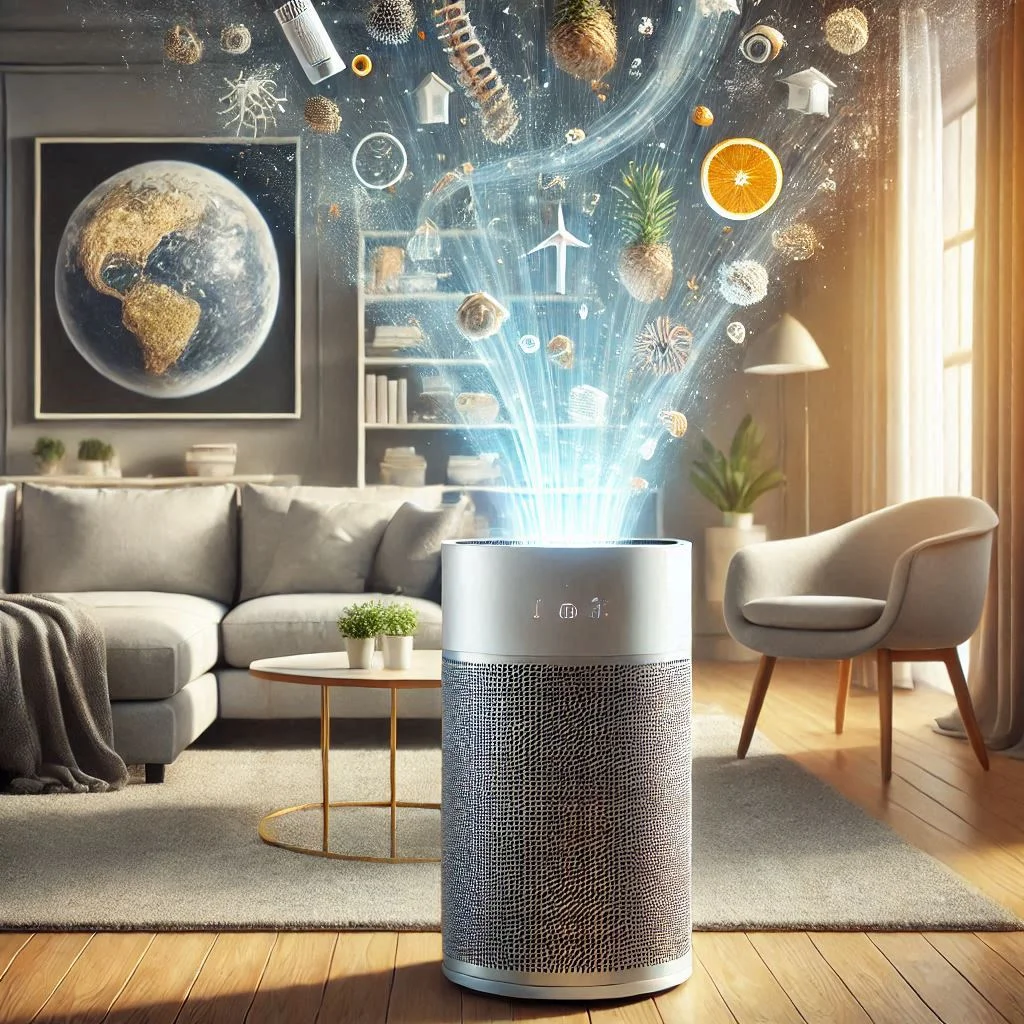
How Air Conditioners Work
An air conditioner (AC) is designed to cool and dehumidify the air in a room, making the environment more comfortable during hot weather. It works through a refrigeration cycle that removes heat from indoor air and expels it outside, thereby lowering the temperature of the indoor space.
Stages of Air Conditioning
- Compression: The AC unit’s compressor compresses refrigerant gas, increasing its pressure and temperature.
- Condensation: The hot, pressurized refrigerant gas is passed through the condenser coils, where it cools down and condenses into a liquid form.
- Evaporation: The liquid refrigerant flows through the evaporator coils, where it evaporates into a cold gas, absorbing heat from the indoor air. This cools the air as it passes over the coils.
- Cooling and Circulation: The cooled air is circulated into the room by the AC unit’s blower fan. The refrigerant absorbs the heat from the air, lowering the overall temperature.
- Dehumidification: As the AC cools the air, it also removes moisture, making the air less humid. This can be particularly beneficial in tropical climates where humidity is high.
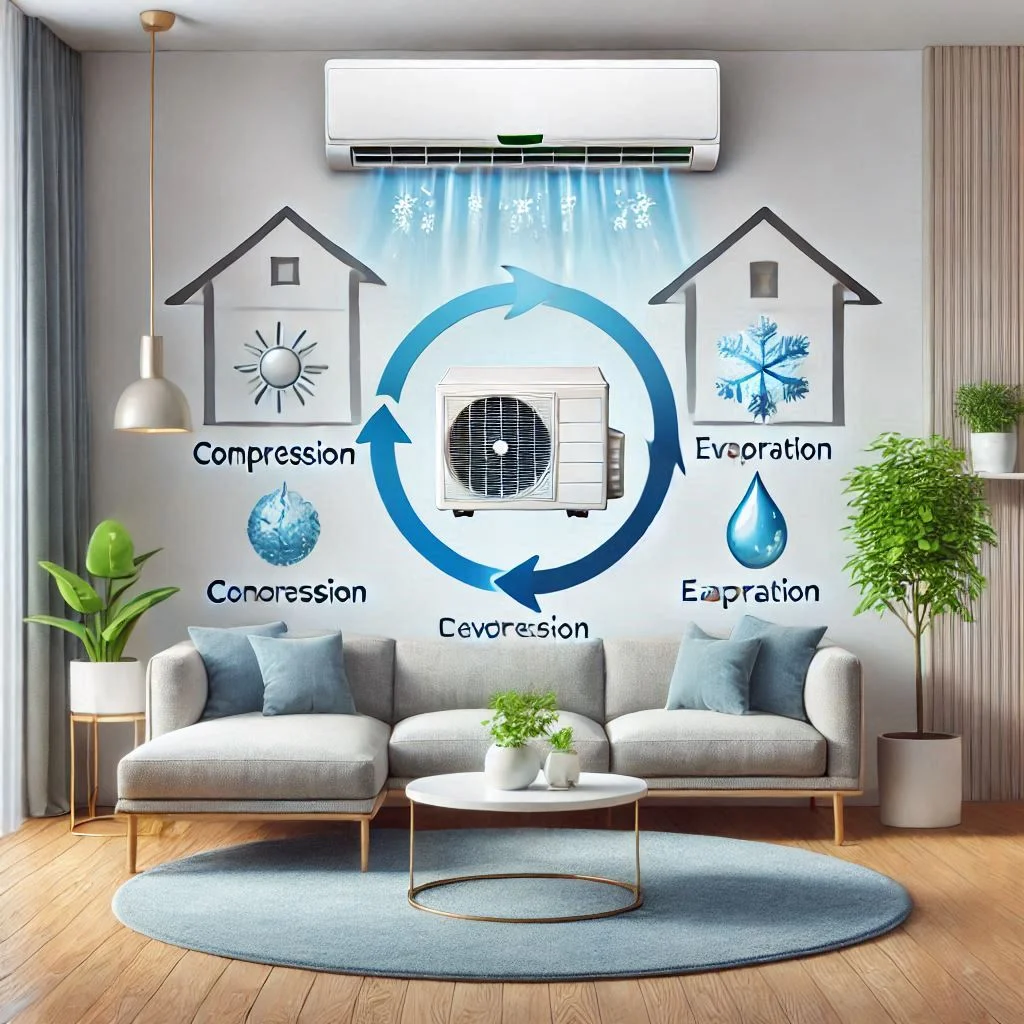
Can Both Devices Trap Pollutants?
While both air purifiers and air conditioners filter air, their abilities to trap pollutants differ significantly due to their distinct designs and functions.
Air Purifiers:
Air purifiers excel at removing microscopic pollutants, such as:
- Dust and Dirt: Captured by the pre-filters and HEPA filters.
- Allergens: Pollen, pet dander, and mold spores are effectively filtered out.
- Odors and Gases: Activated carbon filters help trap smoke, volatile organic compounds (VOCs), and other harmful gases.
- Bacteria and Viruses: UV-C lights or other advanced technologies are designed to destroy harmful microorganisms.
Air Conditioners:
Air conditioners also have filters, but their primary function is to cool the air, not purify it. These filters mainly capture:
- Large Particles: Dust, hair, and debris that could damage the AC unit.
- Basic Pollutants: AC filters can trap some large allergens like dust mites, but they are not as efficient as air purifiers at removing smaller particles and gases.
- Mild Bacteria: Some AC units may have anti-bacterial filters, but they don’t purify the air as extensively as air purifiers.
Overall, air conditioners can help remove some pollutants due to their filters, but they do not provide the level of air purification that air purifiers do. If you’re looking to improve indoor air quality, an air purifier is the more effective choice.
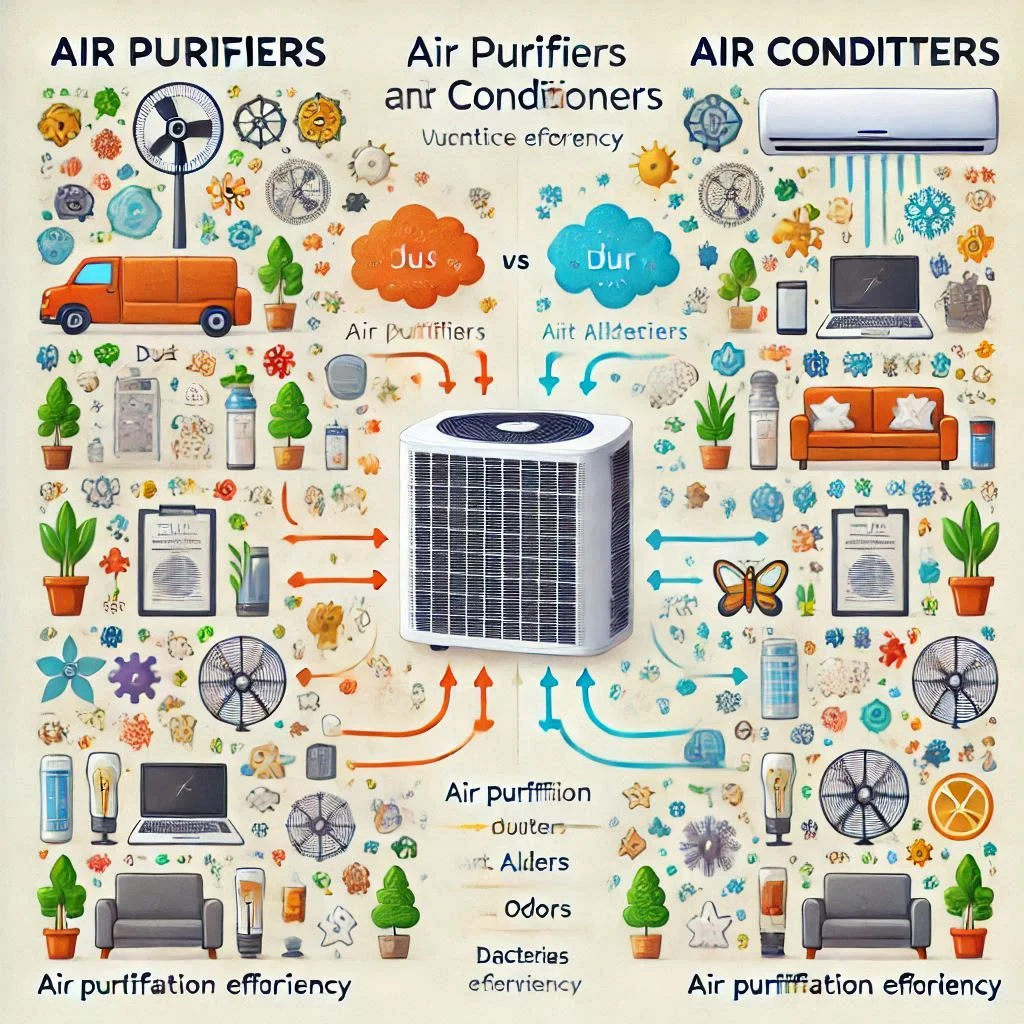
Impact on Indoor Air Quality: Air Purifier vs Air Conditioner
Indoor air quality (IAQ) plays a critical role in your health and well-being, influencing everything from respiratory health to overall comfort. Both air purifiers and air conditioners are essential devices in maintaining a pleasant indoor environment, but they impact air quality in different ways. Here’s a detailed look at how these devices affect the air you breathe.
How Air Purifiers Improve Air Quality
Air purifiers are designed specifically to improve indoor air quality by removing a wide variety of airborne contaminants. Unlike air conditioners, which focus on cooling the air, air purifiers are built with the sole purpose of enhancing the cleanliness and freshness of the air.
1. Removing Particulate Matter
One of the primary ways air purifiers improve air quality is by filtering out particulate matter such as:
- Dust: Air purifiers capture dust particles, which can accumulate in your home and irritate respiratory passages.
- Pet Dander: Pet owners benefit from air purifiers, as these devices trap microscopic dander that triggers allergies and asthma.
- Pollen: For allergy sufferers, pollen is one of the most common airborne irritants. HEPA filters in air purifiers are capable of capturing pollen particles, providing relief.
- Mold Spores: Air purifiers with UV-C or HEPA filters can trap and neutralize mold spores, reducing the risk of mold-related health issues.
2. Eliminating Odors and Harmful Gases
Air purifiers equipped with activated carbon filters absorb odors and gases like:
- Smoke: Cigarette smoke and cooking odors can linger in your home, but air purifiers equipped with carbon filters can eliminate them.
- Volatile Organic Compounds (VOCs): VOCs, which are emitted from products like paints, cleaners, and furniture, can be harmful to health. Air purifiers effectively trap VOCs, ensuring safer air for your family.
3. Destroying Harmful Microorganisms
Many modern air purifiers include UV-C light technology, which helps kill bacteria, viruses, and mold spores, offering a higher level of air sanitation. This is particularly useful for individuals with weakened immune systems or respiratory conditions.
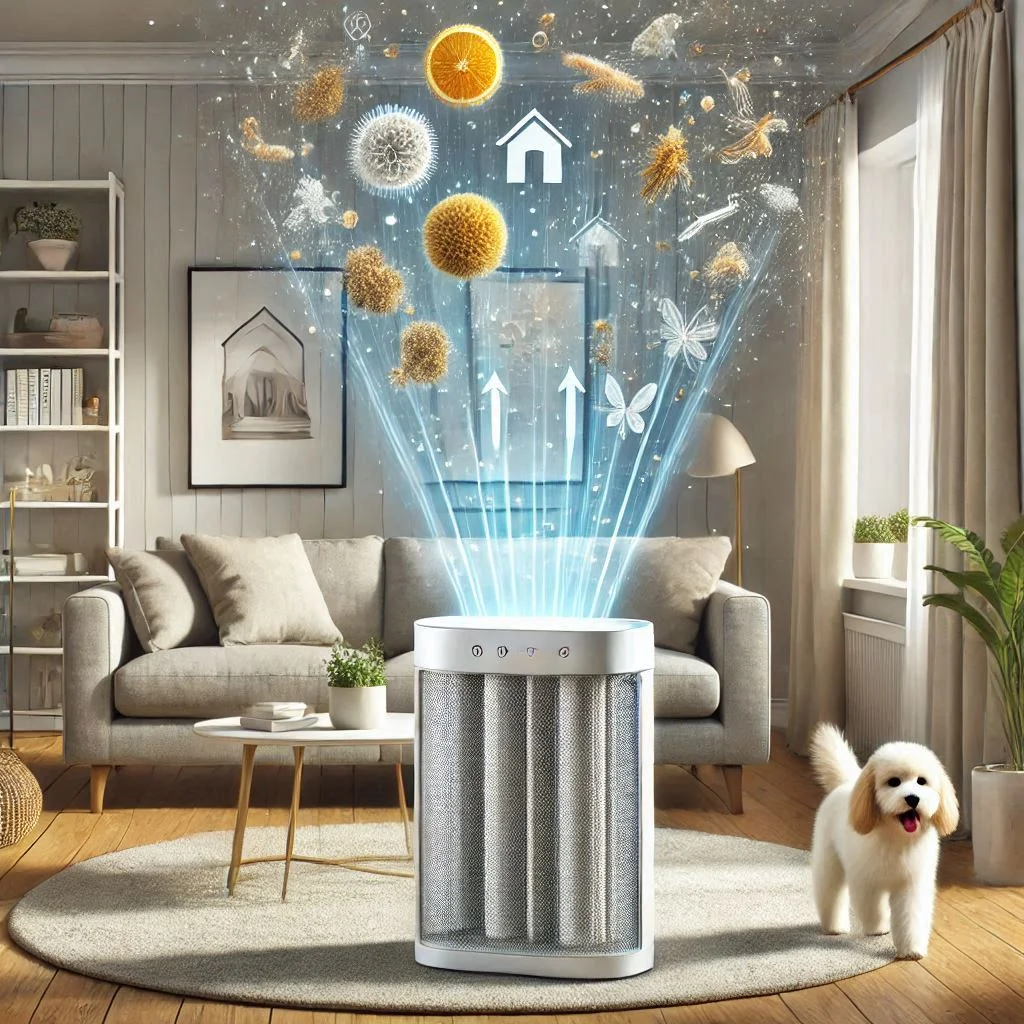
How Air Conditioners Affect Air Quality
While air conditioners primarily focus on temperature control, they do have an impact on indoor air quality as well. However, their role in improving air quality is limited compared to air purifiers.
1. Cooling and Dehumidification
One of the key ways air conditioners affect air quality is by reducing indoor humidity levels. Excess moisture in the air can lead to the growth of mold, mildew, and dust mites, which can negatively impact air quality and trigger allergies. By cooling and removing humidity from the air, air conditioners help maintain a more balanced, comfortable environment.
However, while air conditioners reduce humidity, they don’t actively purify the air. Air conditioners focus on cooling the air but cannot remove airborne pollutants like allergens, bacteria, or VOCs, as air purifiers can.
2. Basic Filtration
Most air conditioners are equipped with filters that capture larger particles like dust, dirt, and pet hair. While this helps maintain a clean AC unit, it doesn’t necessarily improve overall air quality. These filters are not designed to trap finer particles such as pollen, bacteria, or gases that affect indoor air quality.
3. Air Circulation
Air conditioners do help circulate air throughout your home, which can help distribute cleaner air when paired with an air purifier. However, an air conditioner alone will not significantly improve air quality because its filters are not designed to eliminate harmful particles in the air.
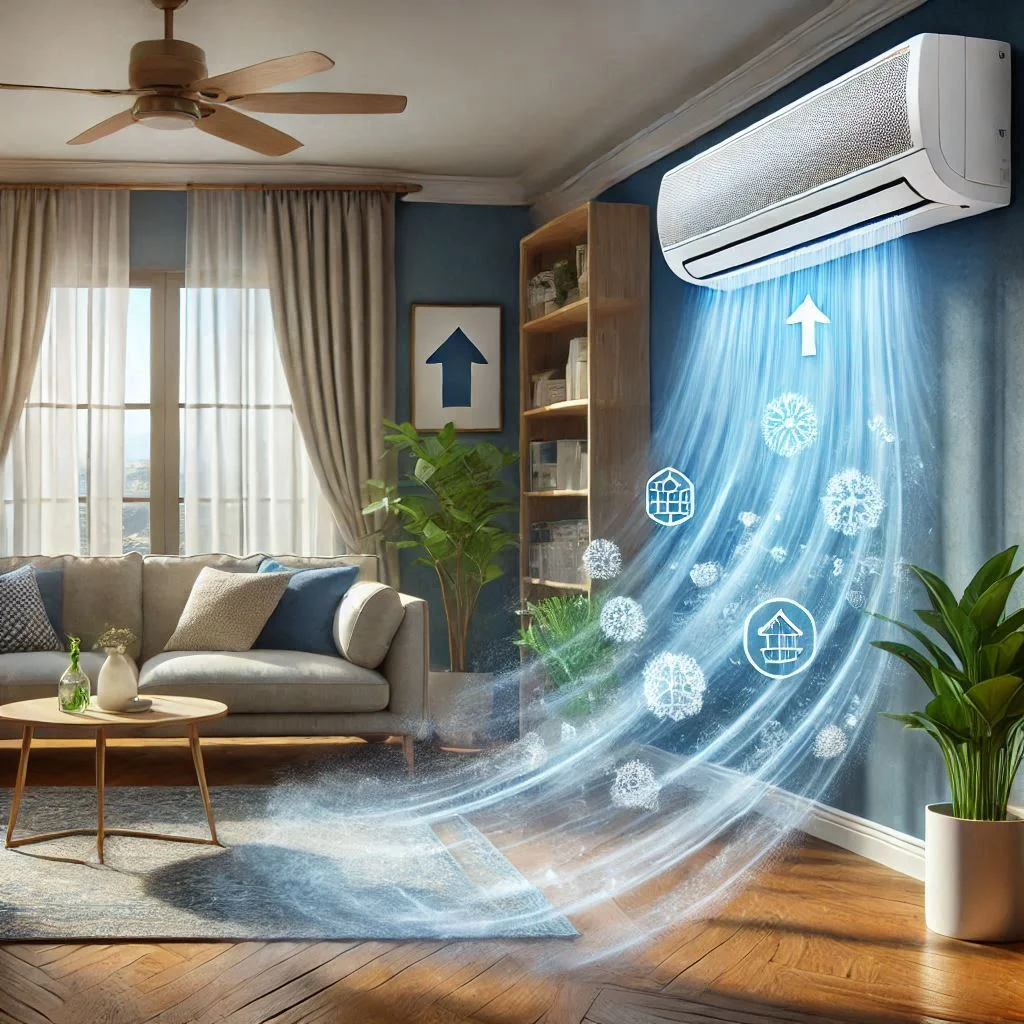
Do Air Conditioners Improve Air Quality?
While air conditioners help manage temperature and humidity, they do not directly improve air quality. However, when used in combination with an air purifier, the overall effect on air quality can be significantly enhanced. Here’s why:
1. Cooling and Comfort
By lowering the temperature and reducing humidity, air conditioners make indoor spaces more comfortable, reducing the growth of mold and dust mites that thrive in humid conditions. This can indirectly improve air quality, but air conditioners are not designed to filter out smaller pollutants that may still remain in the air.
2. Better Air Circulation with Air Purifiers
When an air purifier is placed alongside an air conditioner, the air purifier will clean the air while the air conditioner cools and circulates it. This combination can effectively improve both the temperature and the cleanliness of the air.
3. Maintenance of Air Quality
It’s important to regularly clean and maintain both your air conditioner and air purifier. Dirty filters in an air conditioner can negatively impact its ability to circulate air properly, while a clogged air purifier filter can reduce its effectiveness in removing contaminants.
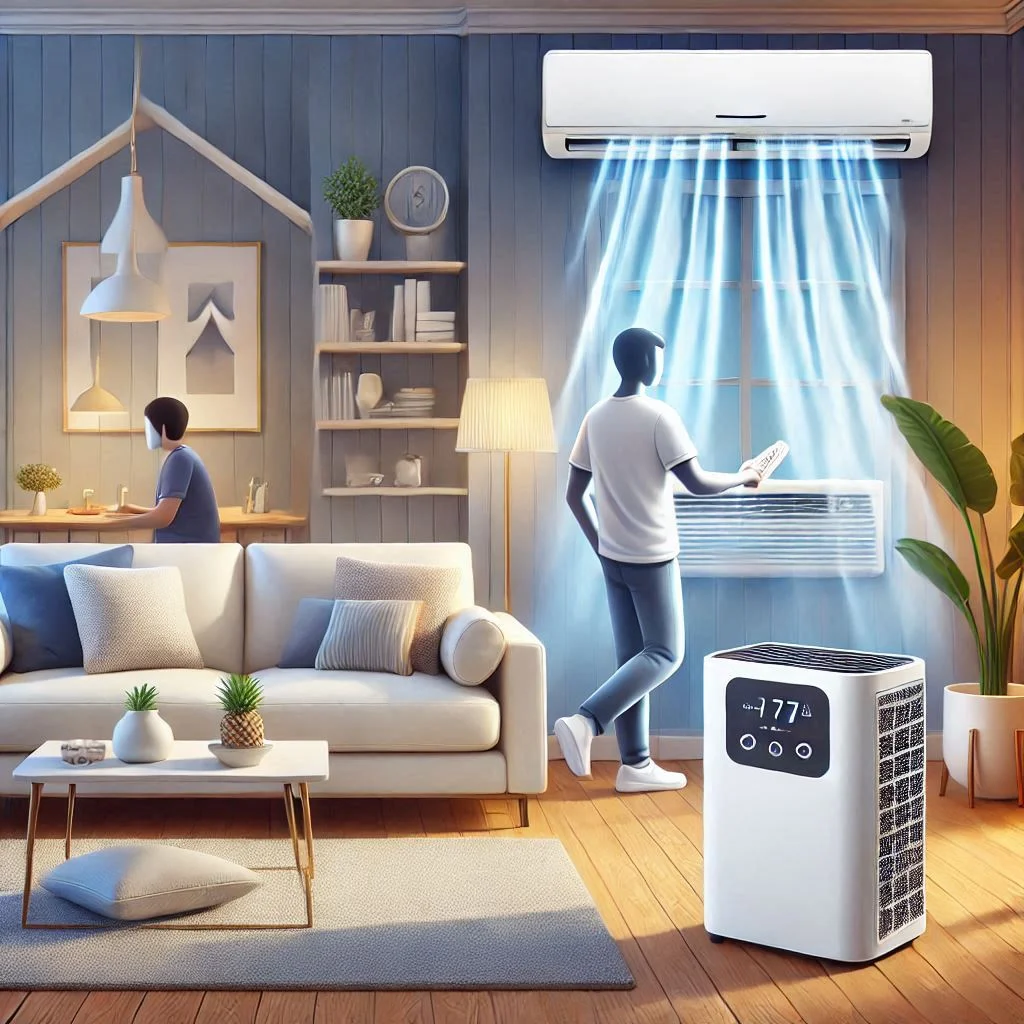
Which One Should You Choose for Your Home?
When deciding between an air purifier and an air conditioner, it’s important to consider your specific needs. Both devices offer benefits, but they serve different purposes. Understanding how each device works and the benefits they provide will help you make an informed decision on which one is best suited for your home.
Key Points to Consider
Before making a decision, it’s essential to evaluate several factors to determine whether an air purifier or an air conditioner will provide the most benefit for your home. Here are some key points to consider:
1. Primary Purpose
- Air Purifiers: If your primary concern is improving indoor air quality, especially if you suffer from allergies, asthma, or respiratory conditions, an air purifier is your best choice. Air purifiers are designed to filter out airborne contaminants like dust, pollen, pet dander, smoke, and bacteria.
- Air Conditioners: If your goal is to keep your home cool and comfortable during hot weather, an air conditioner is the better option. Air conditioners focus on cooling the air and removing humidity, making it ideal for hot, humid climates.
2. Climate and Location
- Air Purifiers: Air purifiers are beneficial in any climate, particularly in areas with high levels of allergens, pollution, or smoke. If you live in a region prone to wildfires or high pollen counts, an air purifier can help reduce the impact of these environmental factors on your health.
- Air Conditioners: If you live in a hot or humid climate, an air conditioner is essential for maintaining comfort. Air conditioners are particularly useful in tropical or subtropical regions where cooling and dehumidification are necessary for comfort and health.
3. Health Considerations
- Air Purifiers: If you or anyone in your household has respiratory issues such as asthma, allergies, or sinus problems, an air purifier can help alleviate symptoms by removing allergens and harmful particles from the air.
- Air Conditioners: While air conditioners are effective for cooling, they do not significantly improve air quality. However, in humid environments, they can help reduce mold growth and prevent the development of moisture-related allergens.
4. Size and Space
- Air Purifiers: Air purifiers come in a variety of sizes and are typically used in smaller, individual rooms or areas. Consider the size of the room where you want to improve air quality. If you have a larger home, you may need multiple units to cover different spaces.
- Air Conditioners: Air conditioners are designed for larger areas and entire homes. You can choose between central AC systems for whole-house cooling or window/portable units for specific rooms.
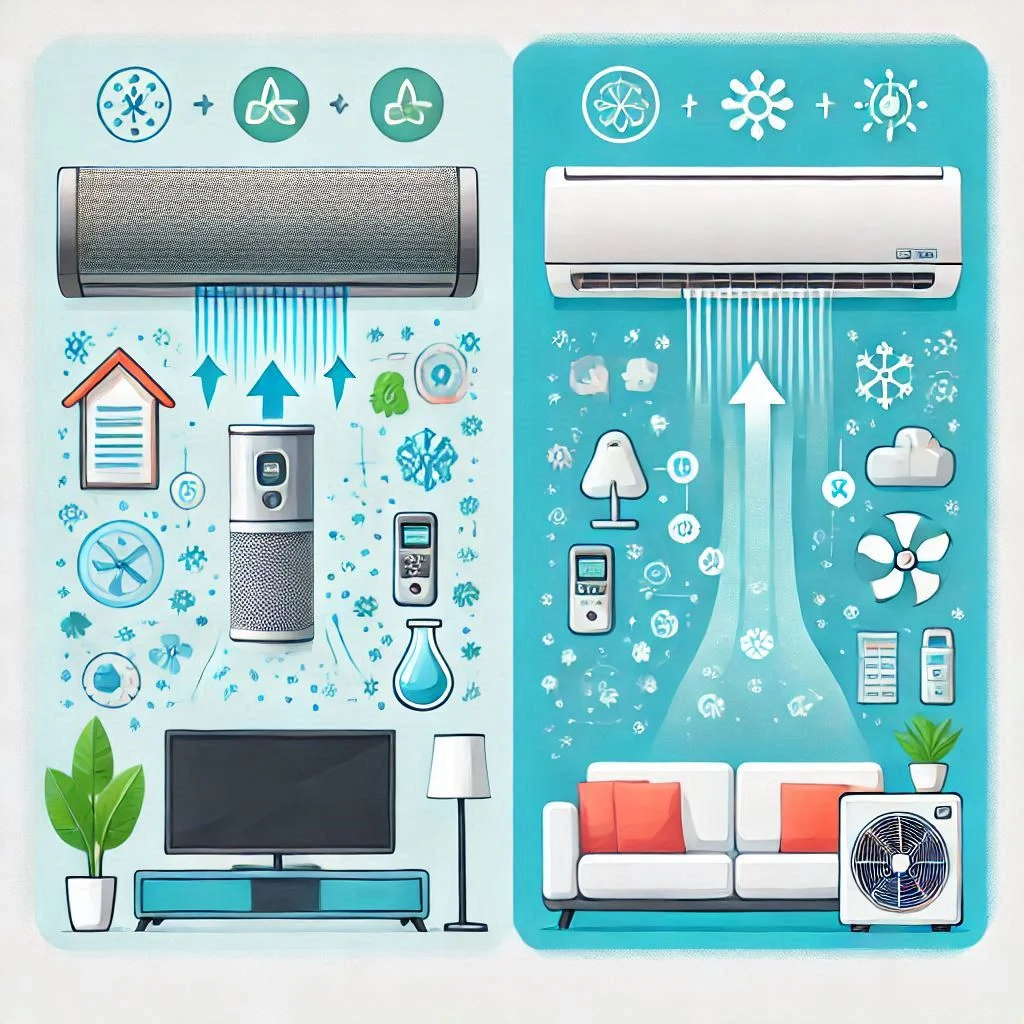
Air Purifier or Air Conditioner: Which Fits Your Needs?
Now that we’ve covered the key considerations, let’s dive deeper into which device best fits your needs. By matching your needs with the right features of these appliances, you can make a more informed decision.
1. Air Purifier: Best for Indoor Air Quality
- Ideal For: Individuals with allergies, asthma, respiratory problems, or anyone looking to improve air quality.
- Key Benefits:
- Removes allergens like pollen, pet dander, and dust.
- Filters out harmful gases such as smoke, VOCs, and odors.
- Helps improve sleep quality by providing cleaner air.
- Can improve overall health by reducing indoor air pollution.
- Recommendation: If you live in an area with high pollution, smog, or pollen, or if your home is subject to smoke (e.g., wildfires), an air purifier is a smart investment. It’s also ideal for anyone with sensitivities to indoor air pollutants.
2. Air Conditioner: Best for Comfort and Temperature Control
- Ideal For: People living in hot and humid climates, or those who need relief from high temperatures during the summer.
- Key Benefits:
- Cools down the indoor air, providing comfort during hot weather.
- Removes excess humidity, preventing mold and mildew growth.
- Increases comfort by maintaining a consistent, cool temperature.
- Recommendation: If you live in a warm climate or experience high humidity, an air conditioner is necessary for keeping your home comfortable. It’s also important for preventing heat-related health issues, especially in the summer.
3. When to Choose Both
In some cases, you may want to use both an air purifier and an air conditioner for the ultimate indoor environment. Here’s when you should consider both:
- Combination of Comfort and Clean Air: If you want to keep your home cool and comfortable while also ensuring the air is free from pollutants, using both devices will be the most effective solution.
- Year-round Comfort: While an air conditioner provides cooling during the summer, an air purifier can improve air quality throughout the year, especially in allergy season.
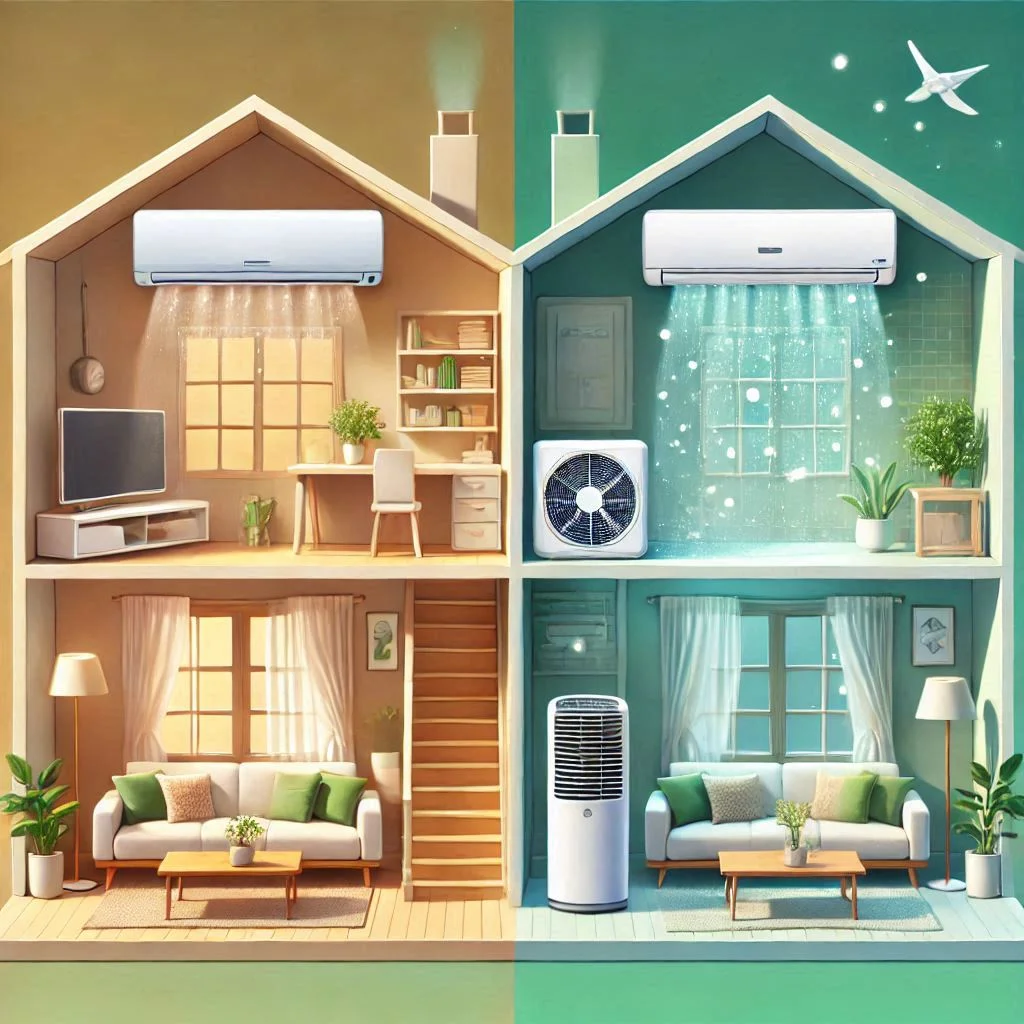
Air Conditioner or Air Purifier: Factors to Consider
When deciding whether to invest in an air conditioner or an air purifier, there are several key factors to take into account. These factors can influence both the effectiveness of the devices and their overall impact on your home environment. Here’s a detailed breakdown of the important considerations you should keep in mind when making your choice.
Space Requirements
The size of your space plays an important role in determining which device will work best for you. Both air conditioners and air purifiers come in a variety of sizes, and selecting the right one for your room size can improve their effectiveness.
1. Air Purifiers and Space Requirements
Air purifiers are designed to be used in individual rooms or smaller spaces, depending on the size of the unit. When selecting an air purifier, it’s important to match its Clean Air Delivery Rate (CADR) with the size of the room. A larger room will require a more powerful air purifier with a higher CADR.
- Small rooms (up to 200 sq. ft.): Choose compact air purifiers designed for smaller spaces.
- Medium-sized rooms (200-400 sq. ft.): Select mid-sized models that offer a balance between power and portability.
- Large rooms (over 400 sq. ft.): For larger spaces, opt for high-capacity units or consider multiple air purifiers.
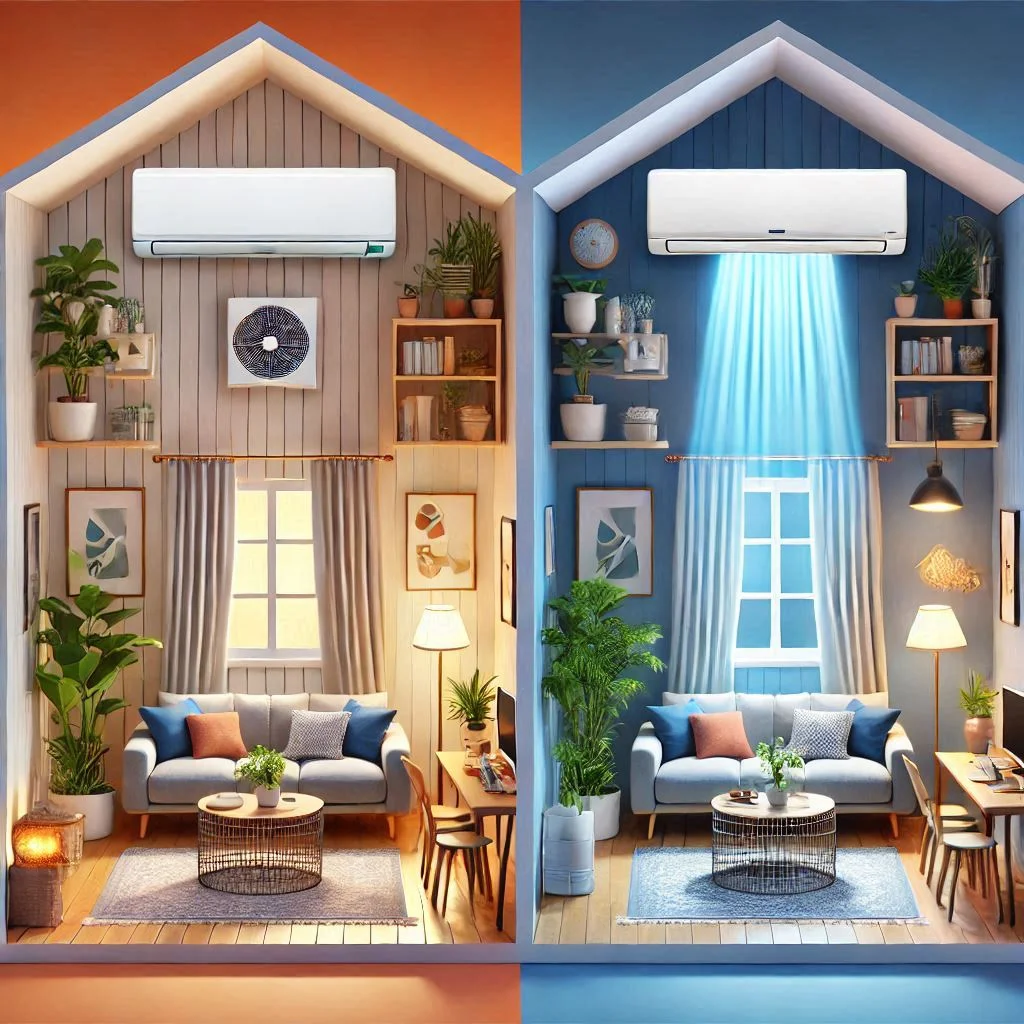
2. Air Conditioners and Space Requirements
Air conditioners, especially window and portable units, are designed to cool a specific area or room. If you’re opting for a window air conditioner, make sure to select a model that matches the size of your room. Similarly, central air conditioning systems are designed to cool an entire home, making them a good choice for larger spaces or multiple rooms.
- Room Size Consideration: If you have a small room, a portable or window unit might be sufficient. Larger spaces or open-floor plans will benefit from a central AC system.
- Placement: The location of the air conditioner is also crucial for optimal cooling. Make sure the unit is placed in a spot where air can circulate freely, ensuring even cooling across the room.
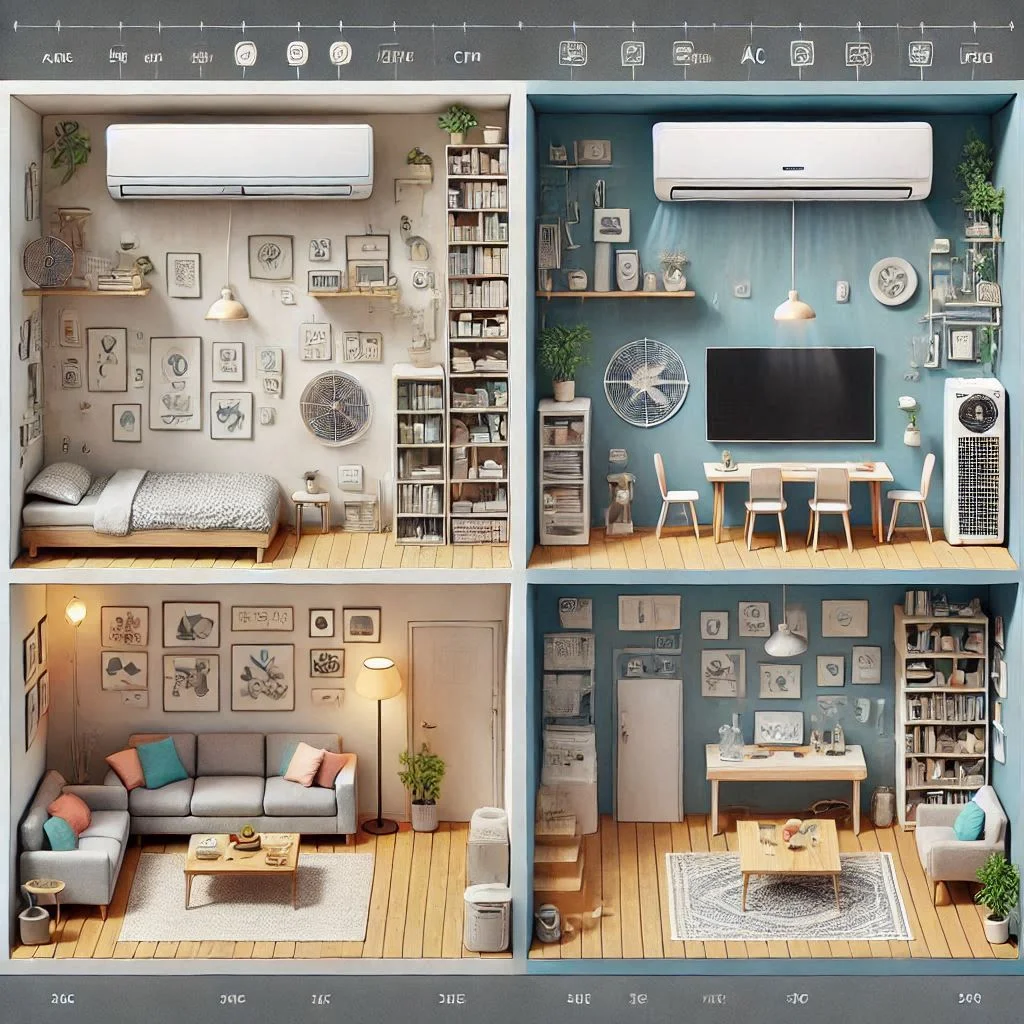
Effectiveness in Pollutant Removal
When it comes to removing pollutants, both air purifiers and air conditioners play different roles. It’s important to consider how each device handles indoor air quality.
1. Air Purifiers: Superior at Pollutant Removal
Air purifiers are specifically designed to target and remove a wide range of airborne contaminants, including:
- Dust: Air purifiers capture particles like dust that can aggravate allergies and respiratory conditions.
- Pet Dander: If you have pets, an air purifier can capture pet dander, preventing allergic reactions.
- Pollen and Mold Spores: Air purifiers equipped with HEPA filters are ideal for capturing pollen and mold spores, which can be harmful to people with asthma and allergies.
- Toxins and Gases: Activated carbon filters in air purifiers effectively trap volatile organic compounds (VOCs) and harmful gases like formaldehyde, making them crucial for improving indoor air quality in households with new furniture, paints, or cleaners.
In essence, air purifiers are highly effective at removing pollutants from the air, improving indoor air quality significantly.
2. Air Conditioners: Limited Pollutant Removal
While air conditioners help cool the air and reduce humidity, they are not equipped to actively remove contaminants like allergens, pet dander, and gases. Most air conditioners only filter out larger particles like dust and dirt. Their primary function is temperature control and comfort, not air purification.
However, some air conditioners come with basic filtration systems that can trap larger particles like dust and dirt, but they are not as effective as air purifiers at filtering smaller pollutants.
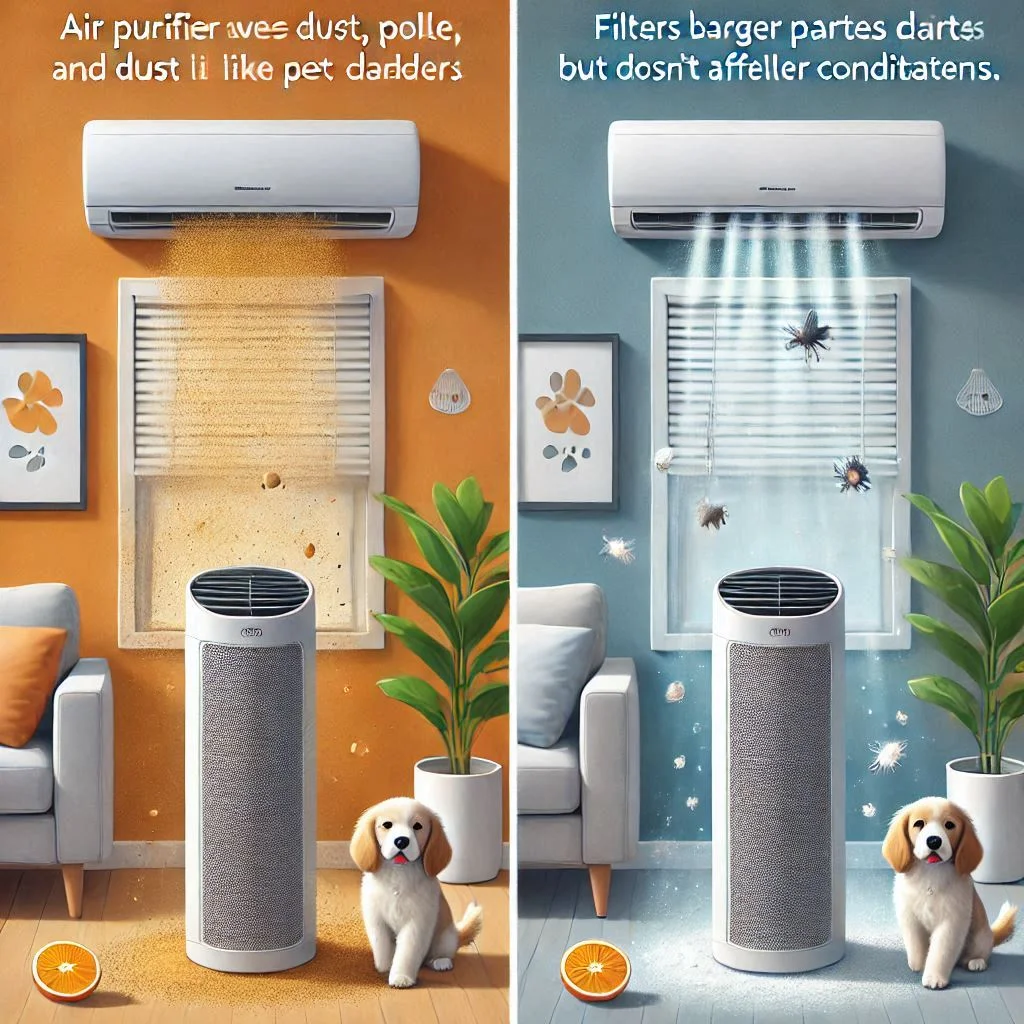
Energy Efficiency and Cost
When choosing between an air purifier and an air conditioner, energy efficiency and cost are crucial factors to consider, especially if you plan to use these devices regularly.
1. Air Purifiers: Energy Efficiency
Air purifiers are generally energy-efficient and cost-effective to operate. Most modern models are designed to run continuously with minimal energy consumption. While the initial cost of an air purifier may vary depending on the brand and features, the ongoing energy costs are typically low.
- Cost of Operation: The average air purifier consumes between 20-100 watts of electricity, depending on the size and power of the unit.
- Maintenance Costs: Regular filter replacement is necessary for optimal performance, but these costs are relatively low compared to other home appliances.
2. Air Conditioners: Energy Consumption and Costs
Air conditioners, particularly window and central AC units, consume more energy than air purifiers. The amount of energy an air conditioner uses depends on several factors, including the size of the unit, the temperature you set, and how long it runs. Central AC systems tend to have a higher upfront installation cost and maintenance requirements.
- Cost of Operation: A typical air conditioner can consume between 500-2000 watts of electricity, depending on the cooling capacity and energy efficiency rating (e.g., SEER rating for central AC systems).
- Maintenance Costs: Air conditioners require regular maintenance, including filter changes, coil cleaning, and refrigerant refills, which can increase the overall cost of ownership.
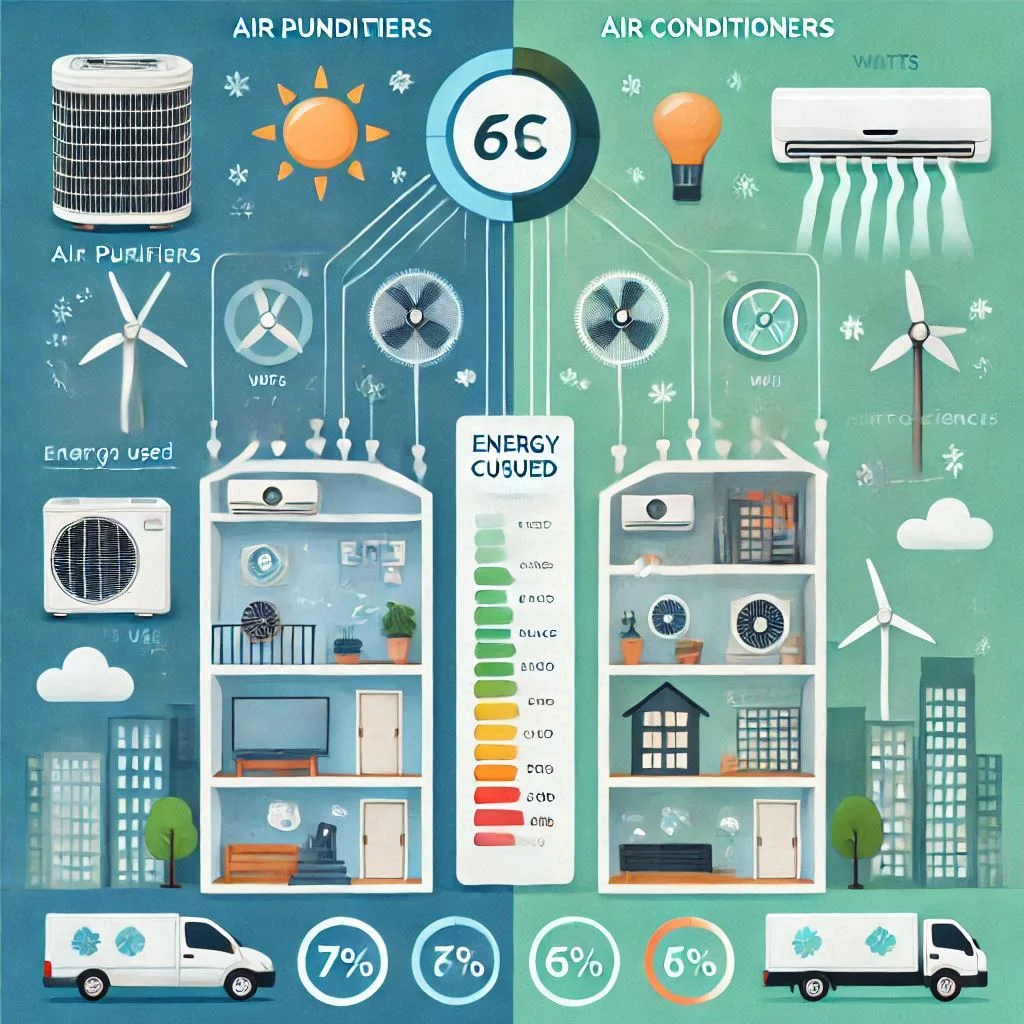
Benefits of Shopping with Bajaj Finserv Financing Options
When purchasing air purifiers and air conditioners, the financial aspect can sometimes be a barrier to getting the device that best fits your needs. Fortunately, Bajaj Finserv offers flexible financing options that make purchasing these home appliances more accessible and affordable. With Bajaj Finserv, you can take advantage of easy-to-manage installment plans, special offers, and discounts.
Affordable Solutions for Air Purifiers and Air Conditioners
One of the primary benefits of shopping with Bajaj Finserv is the affordable solutions they offer for purchasing high-quality air purifiers and air conditioners. Bajaj Finserv provides financing options that enable you to buy these appliances without paying the entire amount upfront. This can make it easier to invest in devices that improve your home’s comfort and air quality without worrying about immediate large expenses.
Flexible Payment Plans
- Bajaj Finserv offers EMI (Equated Monthly Installments) plans that allow you to spread the cost of your air purifier or air conditioner over several months. You can select the EMI tenure that works best for your budget.
- These flexible plans make high-quality air purifiers and air conditioners more affordable for everyone. Whether you’re purchasing a budget-friendly air purifier for small rooms or a high-end air conditioner for your entire home, Bajaj Finserv ensures that payment is never a burden.
Zero Cost EMI Options
- With Zero Cost EMI, you can shop for air purifiers and air conditioners without worrying about interest charges. This option allows you to pay for your device in monthly installments without paying any additional fees or interest, making it a highly attractive way to finance your purchase.
- Affordable, Interest-Free Payments: Zero-cost EMI plans help you keep your overall purchase cost low while still getting the best technology for your home.
Simple Application Process
- Bajaj Finserv’s application process for financing is quick, easy, and hassle-free. You can apply for financing online or at your nearest partner store, and in most cases, the approval is instant.
- Instant Approvals: Once approved, you can instantly use the financing option for purchasing air purifiers, air conditioners, and other home appliances.
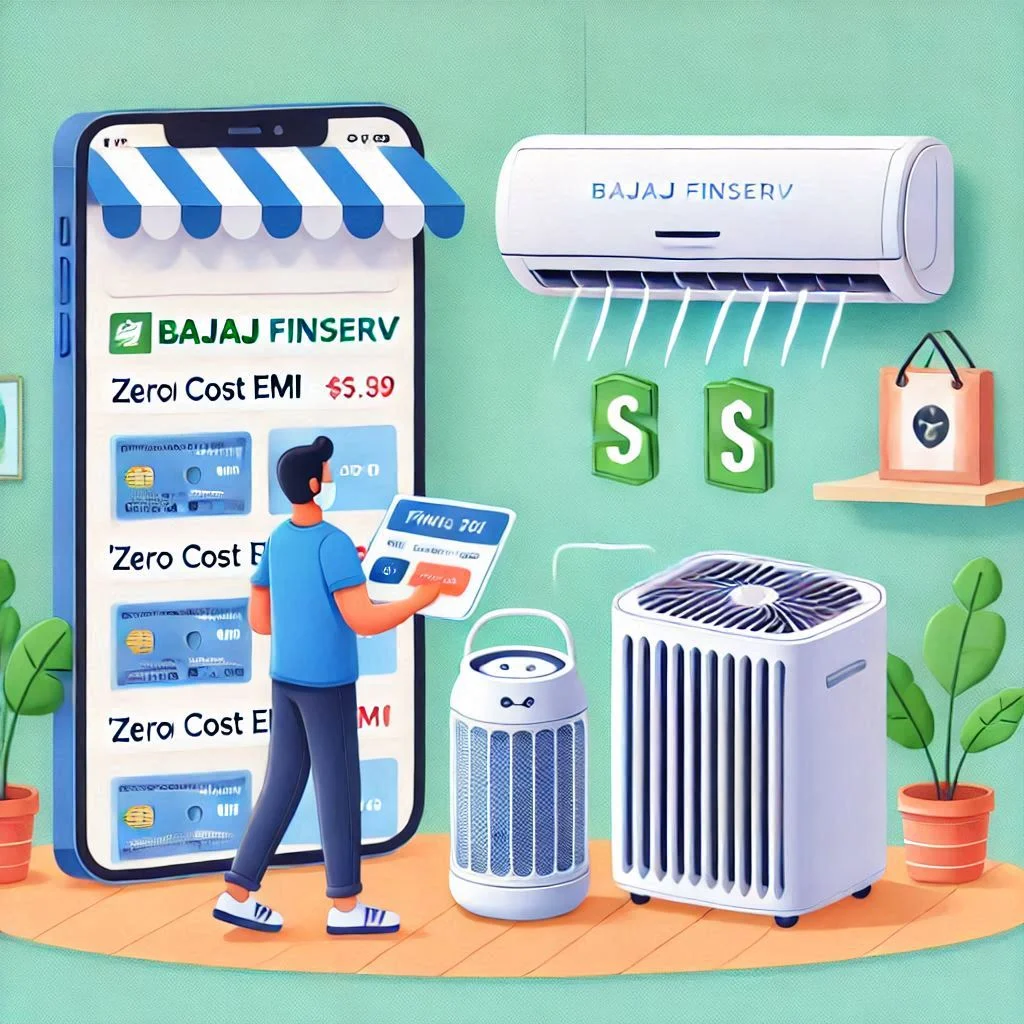
Special Offers and Discounts with Bajaj Finserv
Bajaj Finserv frequently provides special offers and discounts for customers who choose to shop with their financing options. By taking advantage of these offers, you can save money on your air purifier or air conditioner purchase, getting a better deal than you would with traditional payment methods.
Exclusive Discounts for Bajaj Finserv Cardholders
- If you’re a Bajaj Finserv customer or cardholder, you may be eligible for exclusive discounts and promotional offers. These discounts can help lower the cost of your air purifiers and air conditioners, making the purchase even more affordable.
- Partner Discounts: Bajaj Finserv has partnerships with top electronics and appliance brands, ensuring that you can get premium air purifiers and energy-efficient air conditioners at a reduced price.
Seasonal Sales and Limited-Time Offers
- During certain times of the year, Bajaj Finserv offers seasonal sales and limited-time promotions that provide additional savings on top of their standard discounts. These sales events are perfect opportunities to buy high-quality appliances, such as air purifiers and air conditioners, at a fraction of their original price.
- Example Promotions: Look for offers like “Up to 30% off on Air Conditioners this Summer” or “Special Offer on Air Purifiers this Allergy Season.”
Frequently Asked Questions about air purifier vs air conditioner
Here are the most common questions people have when deciding between air purifiers and air conditioners. If you’re unsure about which device to buy or how each device works, this FAQ will help clear things up.
1. What’s the Difference Between an Air Purifier and an Air Conditioner?
The primary difference between an air purifier and an air conditioner lies in their functions:
- Air Purifier: An air purifier is specifically designed to improve indoor air quality by removing pollutants such as dust, pet dander, pollen, smoke, and even harmful gases. It uses a variety of filters, such as HEPA filters and activated carbon filters, to trap particles and keep the air clean.
- Air Conditioner: An air conditioner, on the other hand, is designed to cool the air and maintain a comfortable indoor temperature. While some air conditioners have basic filters to capture larger particles like dust, their main function is temperature control, not air purification.
Key Takeaway: If you’re looking to reduce allergens and pollutants in the air, an air purifier is your best option. If your goal is to cool your living space, then an air conditioner is the right device.
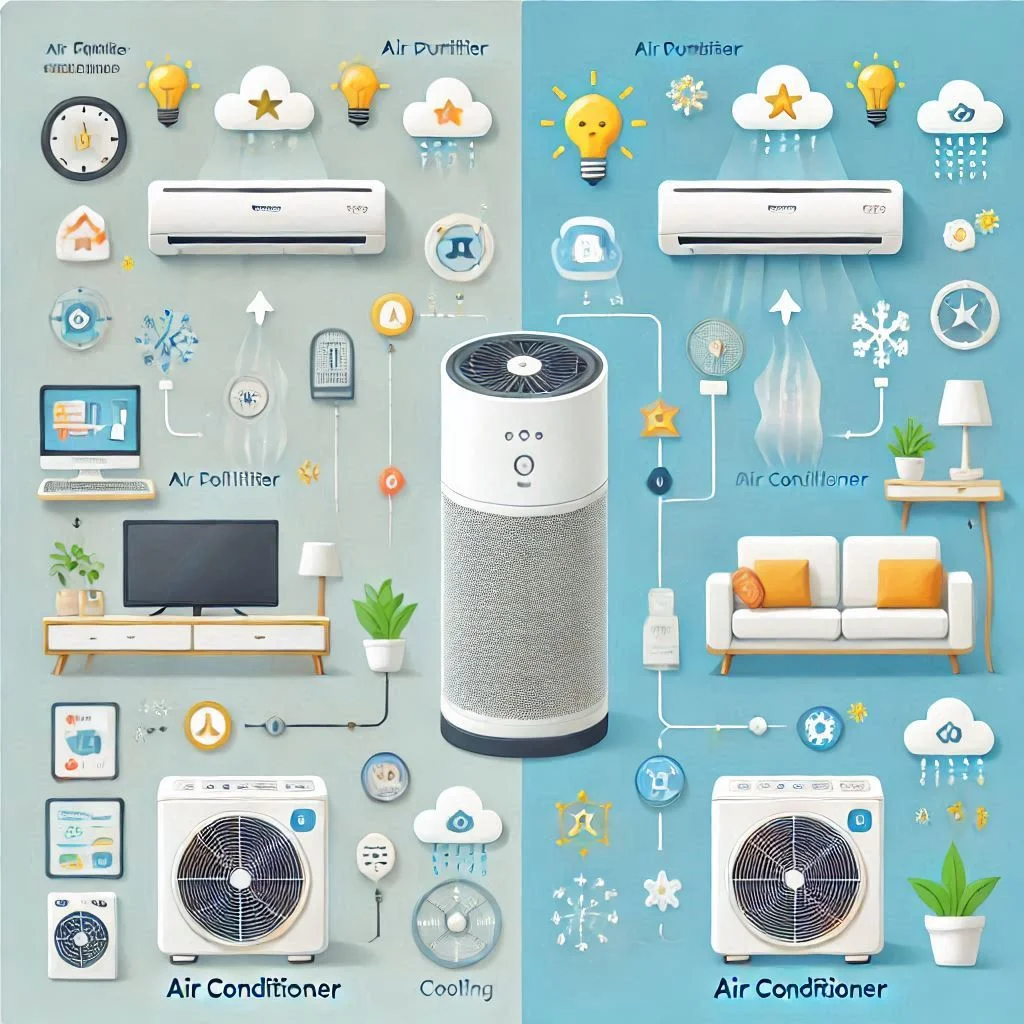
2. Can Air Conditioners Purify Air?
While air conditioners are equipped with basic filters that can capture dust and larger particles, they are not designed to purify the air. An air conditioner’s filter can help reduce the amount of dirt and debris in the air, but it does not eliminate smaller particles like pollen, pet dander, or smoke.
Some advanced air conditioner models come with additional filtration technology, such as air ionizers or UV light filtration, but these are still not as effective as specialized air purifiers when it comes to cleaning the air.
Key Points to Consider:
- Basic filtration: Air conditioners generally only filter out larger particles like dust and dirt.
- Not a replacement for air purifiers: If you need to remove allergens and pollutants from your home, an air purifier is essential, even if you already have an air conditioner.
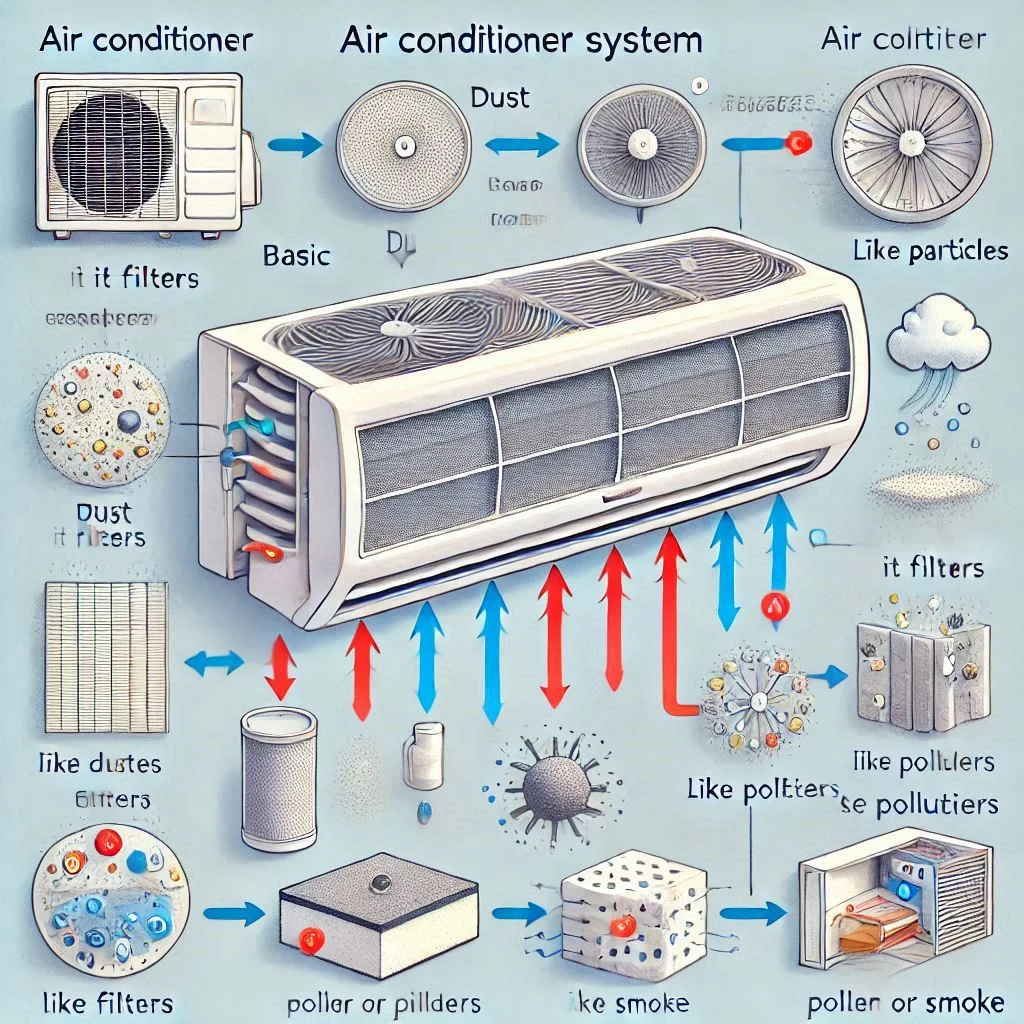
3. How Do I Choose Between the Two?
Choosing between an air purifier and an air conditioner depends on your specific needs and the environment you live in. Here’s a breakdown of what to consider:
Consider an Air Purifier If:
- You suffer from allergies, asthma, or respiratory conditions.
- You live in an area with high pollution, smoke, or pollen.
- You want to eliminate dust, pet dander, or other airborne pollutants in your home.
- You need to create a healthier indoor environment by improving air quality.
Consider an Air Conditioner If:
- You want to regulate the temperature and keep your home cool during hot weather.
- You live in a hot climate or need to manage humidity in your space.
- You don’t have severe air quality concerns and just want to improve comfort.
In some cases, the ideal solution is to use both devices: an air conditioner to control temperature and an air purifier to improve air quality. This combination can offer both comfort and health benefits.
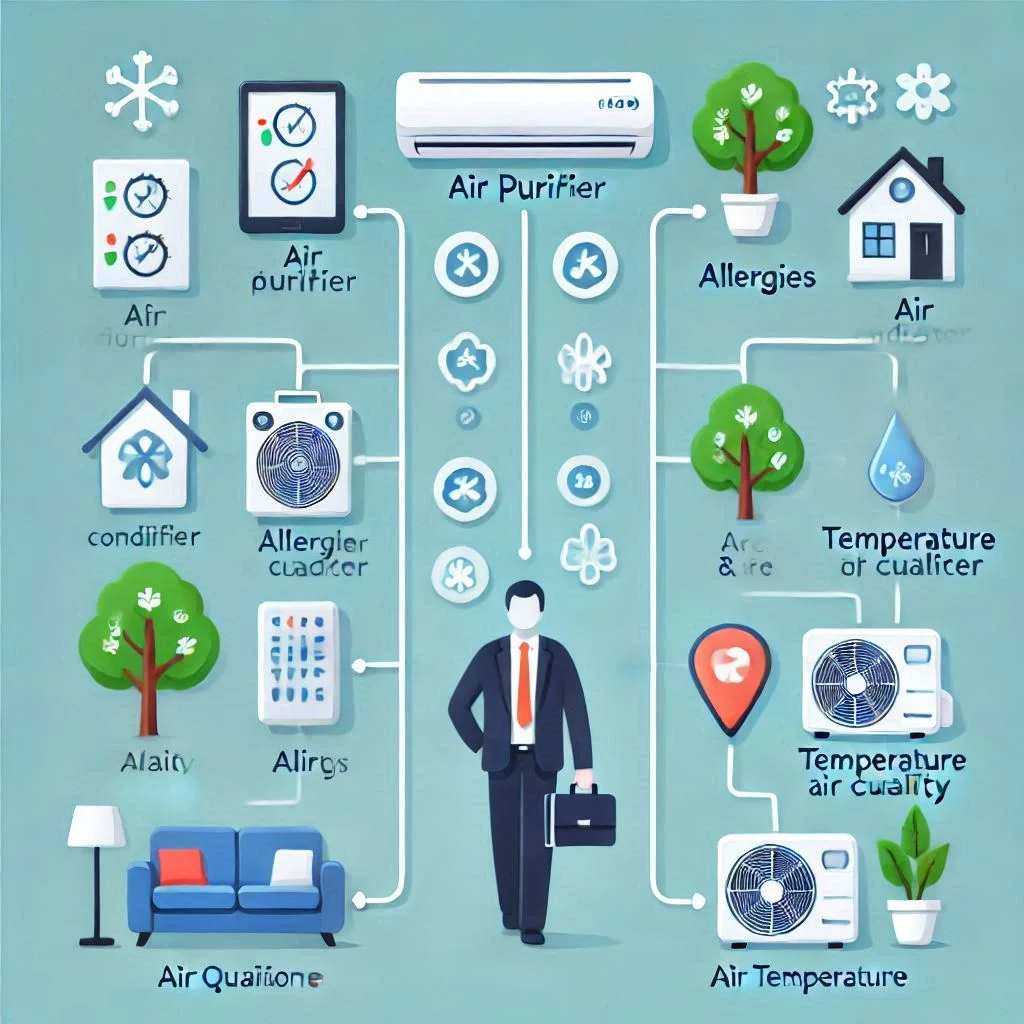
Conclusion of air purifier vs air conditioner
In conclusion, both air purifiers and air conditioners serve unique and essential functions in creating a comfortable and healthy indoor environment. While air purifiers are designed to improve air quality by removing pollutants like dust, pollen, and smoke, air conditioners focus primarily on regulating temperature and humidity for comfort. Understanding the key differences between the two devices, as well as their individual benefits, can help you make an informed decision based on your specific needs. Whether you’re looking to breathe cleaner air or cool down your living space, choosing the right device—or using both together—can significantly enhance your home’s comfort and air quality. Consider factors such as your health concerns, climate, and the type of pollutants you’re dealing with to make the best choice for your home.

